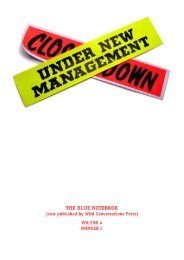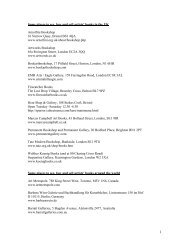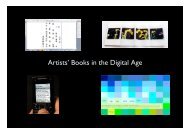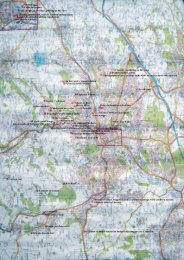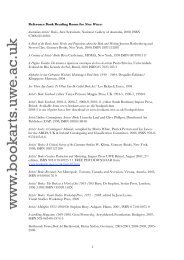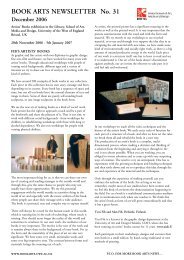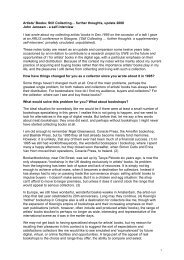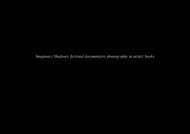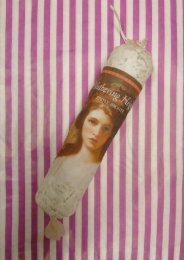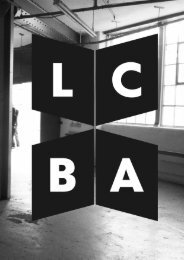Artist's Book Yearbook 2003-2005 - Book Arts - University of the ...
Artist's Book Yearbook 2003-2005 - Book Arts - University of the ...
Artist's Book Yearbook 2003-2005 - Book Arts - University of the ...
You also want an ePaper? Increase the reach of your titles
YUMPU automatically turns print PDFs into web optimized ePapers that Google loves.
The size <strong>of</strong> a book has important consequences<br />
for <strong>the</strong> artist / author and reader relationship.<br />
Verdi Yahooda’s The Dancer (London: Yahooda;<br />
Coracle, 1984) is a 19cm (high) book with<br />
photographs in a black imitation photographic<br />
album. The book is wrapped in a sheet <strong>of</strong> black<br />
binding cloth with black elasticated string (at<br />
least I have always assumed that <strong>the</strong>se were an<br />
intended part <strong>of</strong> <strong>the</strong> book): <strong>the</strong>re is a real sense<br />
<strong>of</strong> intimacy as one unwraps <strong>the</strong> book and <strong>the</strong>n<br />
follows through a private photographic album,<br />
looking at her deceased mo<strong>the</strong>r’s mementoes<br />
kept in a box on <strong>the</strong> dressing table. The size <strong>of</strong><br />
<strong>the</strong> book insists on this one to one relationship<br />
– you, <strong>the</strong> reader, have been privileged to see<br />
inside this private cache, however factitious,<br />
almost as if you are a voyeur. Anselm Kiefer’s<br />
large and heavy lead-covered books are at <strong>the</strong><br />
o<strong>the</strong>r extreme: <strong>the</strong>y require <strong>the</strong> help <strong>of</strong> several<br />
assistants to turn <strong>the</strong> pages; you can only see<br />
what somebody else has decided what you can<br />
see – it is <strong>the</strong> page/spread as exhibition piece.<br />
The ‘average size’ book lies in <strong>the</strong> terrain<br />
between extremes. A sort <strong>of</strong> ergonomic – easy<br />
to hold or carry, not too heavy, easily shelved<br />
and retrieved – balance has been attained, a<br />
sort <strong>of</strong> bourgeois equivalent to <strong>the</strong> easelpainting<br />
that replaced large-scale tapestries and<br />
paintings, <strong>the</strong> domain <strong>of</strong> kings and princes.<br />
The large book is redolent <strong>of</strong> authority, power<br />
and authority: it is <strong>the</strong> authorised text <strong>of</strong> <strong>the</strong><br />
Bible, lying on aquiline lecterns, read out by<br />
clerics to <strong>the</strong> laity; it is <strong>the</strong> book <strong>of</strong> audit and<br />
taxation – reinforcing Levi-Strauss’ equation <strong>of</strong><br />
writing and oppression; it is <strong>the</strong> atlas <strong>of</strong><br />
domination; it is <strong>the</strong> potlatch or symbol <strong>of</strong><br />
conspicuous consumption <strong>of</strong> <strong>the</strong> medieval lord<br />
or rich merchant. One <strong>of</strong> <strong>the</strong> decisive moments<br />
in <strong>the</strong> history <strong>of</strong> <strong>the</strong> book is <strong>the</strong> movement<br />
away from speaking aloud – to an audience -<br />
to ‘reading’ words, silently, privately, as an<br />
individual. This was essential to <strong>the</strong> rise <strong>of</strong> <strong>the</strong><br />
novel and its own project <strong>of</strong> realism, a<br />
recreation <strong>of</strong> <strong>the</strong> world in detail.<br />
Perhaps one <strong>of</strong> ‘largest’ books is that one<br />
detected by Paul Auster’s detective, Quinn, in<br />
The City <strong>of</strong> Glass. Commissioned by <strong>the</strong> younger<br />
Stillman afraid <strong>of</strong> what his fa<strong>the</strong>r will do to him<br />
on his release from gaol, Quinn follows <strong>the</strong><br />
elder Stillman’s perambulations through an<br />
area <strong>of</strong> New York bounded by 110th and 72nd<br />
48<br />
Streets, picking up and examining found<br />
objects, making notes in a red notebook.<br />
Translating <strong>the</strong>se wanderings over <strong>the</strong> days into<br />
rough diagrams, Quinn, detects OWEROFBAB,<br />
which given four earlier days, is inescapably,<br />
THE TOWER OF BABEL. This is a gigantic<br />
book, <strong>the</strong> world as book – but it can only exist<br />
within <strong>the</strong> confines <strong>of</strong> Auster’s moderately sized<br />
book. Multum in parvo.<br />
Dr Stephen Bury<br />
Head <strong>of</strong> European and American Collections,<br />
The British Library




